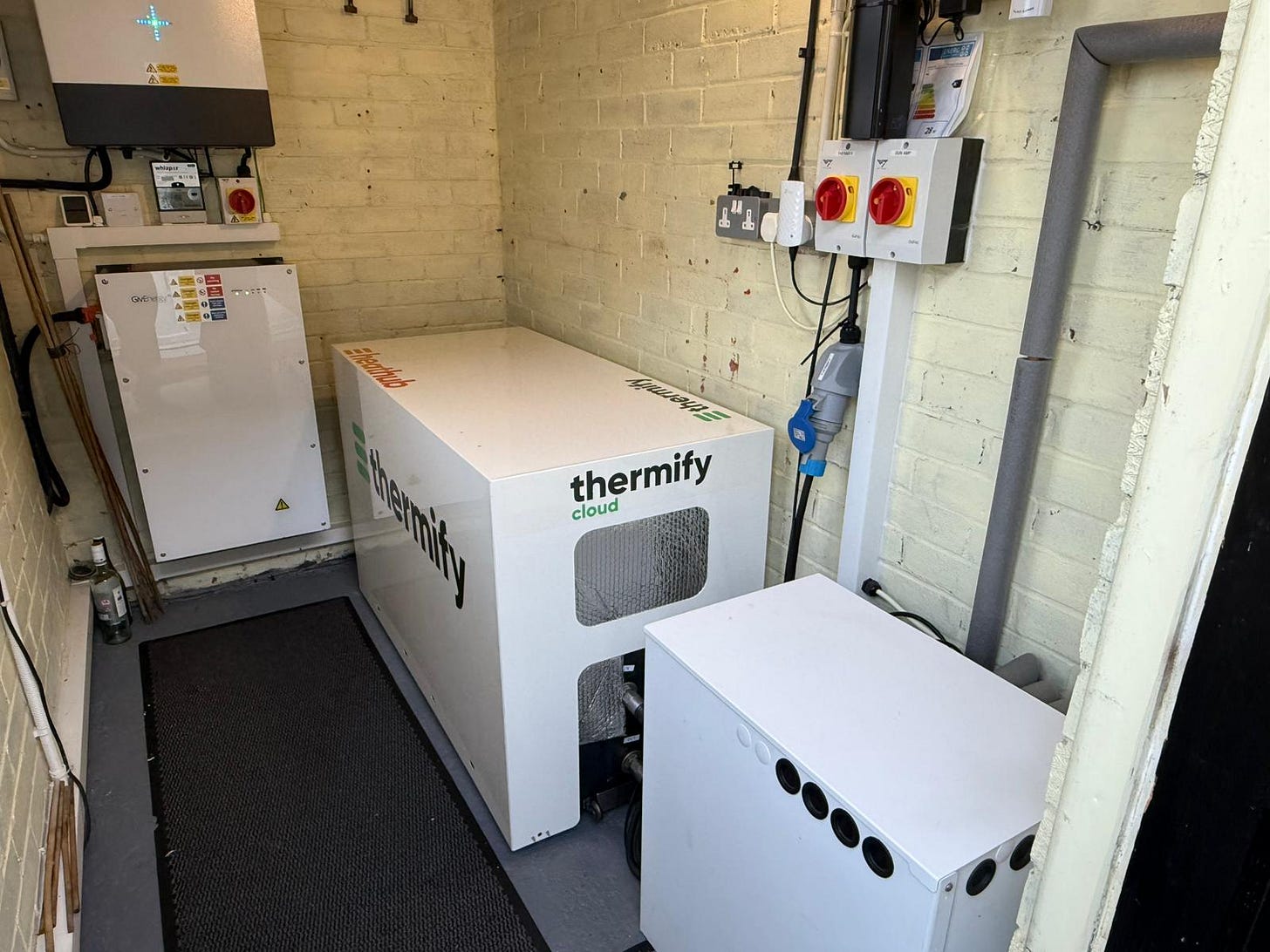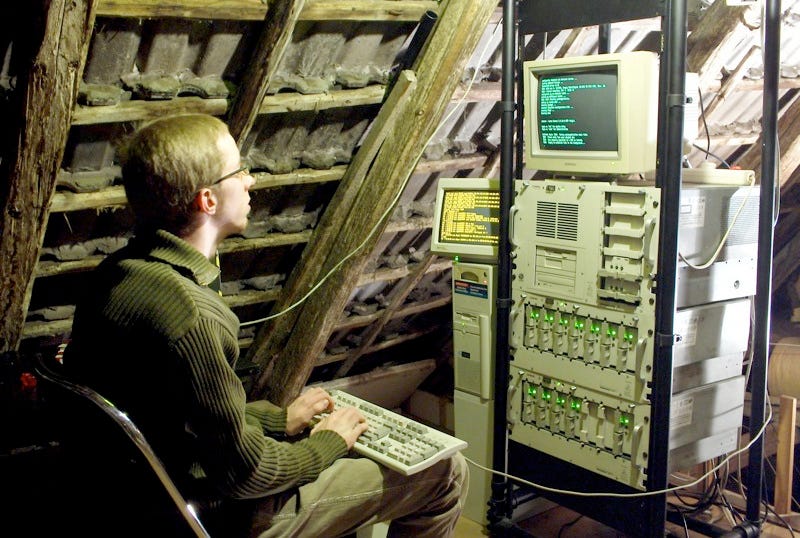Sheds and garages to become mini data centres in low-cost heating drive
A UK firm says distributed computing can tackle fuel poverty

In deepest Essex, 500 tiny computers stacked together and immersed in a heat-absorbing oil are working away in a brick shed in a garden. These low-cost Raspberry Pi computers, which are often used by schools and hobbyists, are processing data – and keeping a couple in their 70s warm.
Earlier this month, Terrence and Lesley Bridges spoke to the press about their new heating system. “It truly is brilliant,” Mr Bridges told BBC News. The pair’s old gas boiler had been costing them £375 per month but the new tech, provided by a Wales-based start-up called Thermify, is currently supplying them with heat at a cost of just £40 per month.
Computers get hot. That’s why your laptop has fans built into it – to draw relatively cool air over the processor while it works. Most of the time, the expelled heat is wasted. But some people say we could be making far better use of it: for example, to heat buildings. The mini data centre in the Bridges’ garden shed is an example of this.
“We want to make it so nobody has to choose between heating and eating,” says chief executive Travis Theune, who argues that mini data centres can lower heating costs and tackle fuel poverty, especially when leased through social housing organisations. The idea is to distribute hundreds of the devices around Britain, installing them in people’s sheds, garages and utility rooms. But can it grow to any meaningful scale?
News reports about the first installation of Thermify’s HeatHub technology in Essex generated lots of questions from web users, so The Reengineer contacted the company to find out more.
Harvesting waste heat from data centres is far from a new idea. Firms have experimented with it for decades – and I think I’m correct in saying that old water-cooled IBM mainframes of the 1980s did, in some cases, provide heat to office buildings. Waste heat from data centres has warmed Olympic swimming pools and city districts, including in countries as cold as Finland.
‘Chopped up’ data centre
But Thermify’s idea is unusual. Traditionally, data centres are large facilities that house a plethora of powerful computers, perhaps thousands of them. Many of the digital tasks you do, from browsing the web to editing an online document, actually happen in these facilities – commonly referred to as “the cloud”.
“Rather than distribute the heat, we distribute the data centre,” says Darran Ford, carbon reduction director at Simcott Renewables, an energy tech firm contracted to install the Thermify technology. “We chop [the data centre] into small bits and put it into people’s houses.”
So, in this case, Thermify will charge companies looking for cloud services to make use of these distributed, mini data centres. Like sending out lots of different crossword puzzles to multiple homes and then getting the answers back in the post. It’s just, er, a bit quicker than that.

The crucial thing is that the heat is generated right where it is needed, meaning fewer losses than if you were to transport that warmth over long distances. And, the mini data centre only works when heat is required – meaning it will run far less during the summer.
Heat generated by the Raspberry Pi computers seeps into the oil that surrounds them. Theune declined to confirm what oil the system uses though he said that while some earlier tests of the equipment used a petroleum-based oil, the company will switch to a non-petroleum-based oil for commercial versions of the technology. In any case, the warmed oil passes its heat to a heat exchanger, which ultimately warms up water for the home. That heat can be stored in a thermal battery, too.
Ford mentions that the first Thermify installation can achieve higher flow temperatures to radiators than anticipated. “We set it up as though we were installing a heat pump,” he says, explaining that his team planned for flow temperatures of around 50C. But actually the HeatHub can output as much as 70-80C at present.
More on the way
While the Bridges’ unit is the pilot version, Theune says 100 more devices are booked in for installation during the next two years. Ford’s firm will begin working on these in 2026 and the next one is to be fitted within a brick outhouse attached to a property. Electricity consumed by these systems will be paid for by Thermify – there will be separate metering for the mini data centres.
Ford says that the HeatHub produces roughly 0.8 kilowatt hours of heat per kilowatt hour of electricity it consumes. That’s much lower than a heat pump, which ought to get you around 3 kilowatt hours of heat, or more, per kilowatt hour of electricity. However, Ford argues the HeatHub is, in a sense, “more efficient” because it is making use of waste heat from computational processes that would be happening anyway.
Currently, the HeatHub box containing all those Raspberry Pis is roughly the size of a small chest freezer, but the aim is to reduce this substantially until it is comparable to a standard gas combi boiler. Ford mentions that the box could in theory be housed in waterproof casing and bolted on to the external walls of homes.
The unit generates some noise, at present about 25-30 decibels at a distance of one metre. Thermify is targeting noise levels below 20 decibels at that distance, says Theune.
He stresses that there are some forms of computation for which the system wouldn’t be suitable. Training large language models (the tech behind generative AI) requires large, centralised data centres, for example. But processing data for users of apps, or rendering video for non-streaming purposes would work, for instance.
HeatHub or porn hub?
I ask whether people might have concerns about certain kinds of data processing happening on their own property – not everyone may be comfortable with the idea of their shed being used to process (legal) pornography, for example.

“We won’t know what kind of processing is going to be happening on individual machines,” says Theune. He says, though, that Thermify aims to ensure the system will not be used for anything illegal. He also suggests avoiding processing highly sensitive or personally identifying information on the system, especially during its initial rollout.
This points to one concern many people have raised about the technology: how secure is it? What’s to stop someone tampering with a device that’s tucked away in a suburban garage?
“We do take this very, very seriously,” says Theune. While he declines to share much detail, he says the system has been designed to spot interference or meddling with its power supply or data processing. “The systems are encrypted internally,” says Theune. “If we detect a problem with the system, we just destroy the keys for the encryption and wipe the data that is local.”
Were this ever to happen, a service engineer would then have to visit the unit to reset it. In terms of general maintenance, should one of the many modules containing some of the Raspberry Pis ever fail, that would also require a manual call-out.
Stacking up
But perhaps the biggest question of all is whether this is an economically viable approach. People who decide to switch to Thermify and put in a HeatHub instead of a gas boiler or heat pump will care about that because their ongoing use of the system will likely be tied to the company’s fortunes.
Theune says the firm is still thrashing out the details of an early adopter programme for clients who want to make use of the distributed data centres’ processing power but the goal is a price of around 4p per CPU hour. This is within industry price ranges, though those figures vary depending on the kind of computation required and, as mentioned, Thermify won’t handle all kinds of processing.
The challenge is in selling all of this to companies hungry for cloud computing resources. Thermify must compete with increasingly gargantuan, and energy efficient large-scale data centres already offering low prices for the simplest forms of computation. But with so much demand for data centre services at the moment, Theune seems confident that his company will find a niche.
“Cloud computing isn’t going anywhere, so let’s make it work for us instead of against us,” he says.
Further reading on this week’s story
A 2023 study explores the various ways in which heat can be harvested from data centres – including from their cooling fluids but also from warm expelled air.
There is enough heat escaping from data centres in London alone to heat half a million homes, according to a report published by the Greater London Authority (PDF) earlier this year.
Thanks for reading! If you enjoyed this story, don’t forget to share it with your friends and colleagues. You can also subscribe to The Reengineer and follow me on Bluesky.


